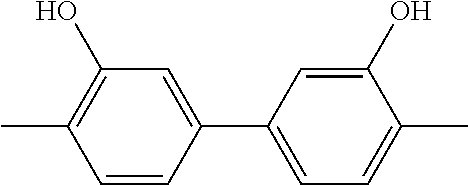High selectivity copolyimide membranes for separations
- Summary
- Abstract
- Description
- Claims
- Application Information
AI Technical Summary
Benefits of technology
Problems solved by technology
Method used
Image
Examples
example 1
Synthesis of TD-PI-3-2 Copolyimide
[0040]An aromatic poly(3,3′,4,4′-diphenylsulfone tetracarboxylic dianhydride-3,3′,5,5′-tetramethyl-4,4′-methylene dianiline-3,3′-diaminodiphenyl sulfone) copolyimide (abbreviated TD-PI-3-2) containing UV cross linkable sulfonic group was synthesized from the polycondensation reaction of 3,3′,4,4′-diphenylsulfone tetracarboxylic dianhydride (DSDA) with a mixture of 3,3′,5,5′-tetramethyl-4,4′-methylene dianiline (TMMDA) and 3,3′-diaminodiphenyl sulfone (3,3′-DDS). The molar ratio of TMMDA to 3,3′-DDS was 3:2 and this specific copolyimide polymer described here was abbreviated as TD-PI-3-2. The polymerization reaction was carried out in anhydrous dimethyl acetamide (DMAc) polar solvent by a two-step chemical imidization process involving the formation of the poly (amic acid) in the first step followed by a solution imidization process. For example, a 500 mL three neck round bottomed flask equipped with a nitrogen inlet and a mechanical stirrer was char...
example 2
Preparation of TD-PI-3-2 Dense Film Membrane
[0041]The TD-PI-3-2 dense film membrane was prepared as follows: 5.0 g of TD-PI-3-2 copolyimide was added to 20.0 g of NMP. The mixture was mechanically stirred for 2 hours to form a homogeneous casting dope. The resulting homogeneous casting dope was filtered and allowed to degas overnight. The TD-PI-3-2 copolyimide polymer dense film membrane was prepared from the bubble free casting dope on a clean glass plate using a doctor knife with 20 mil gap. The membrane was dried at 62° C. for 12 h on a hot plate to remove the solvent. Finally, the membrane was removed from the glass plate and further dried at 200° C. under vacuum for at least 48 h to completely remove the residual solvent to form TD-PI-3-2 dense film membrane.
example 3
Preparation of UV Cross-Linked TD-PI-3-2 Dense Film Membrane
[0042]The TD-PI-3-2 dense film membrane prepared in Example 2 was further UV cross-linked by exposure to UV radiation using 254 nm wavelength UV light generated from a UV lamp with 1.9 cm (0.75 inch) distance from TD-PI-3-2 dense film membrane surface to the UV lamp and a radiation time of 10 min at 50° C.
PUM
| Property | Measurement | Unit |
|---|---|---|
| Pressure | aaaaa | aaaaa |
| Mass | aaaaa | aaaaa |
| Temperature | aaaaa | aaaaa |
Abstract
Description
Claims
Application Information
 Login to View More
Login to View More - R&D
- Intellectual Property
- Life Sciences
- Materials
- Tech Scout
- Unparalleled Data Quality
- Higher Quality Content
- 60% Fewer Hallucinations
Browse by: Latest US Patents, China's latest patents, Technical Efficacy Thesaurus, Application Domain, Technology Topic, Popular Technical Reports.
© 2025 PatSnap. All rights reserved.Legal|Privacy policy|Modern Slavery Act Transparency Statement|Sitemap|About US| Contact US: help@patsnap.com



